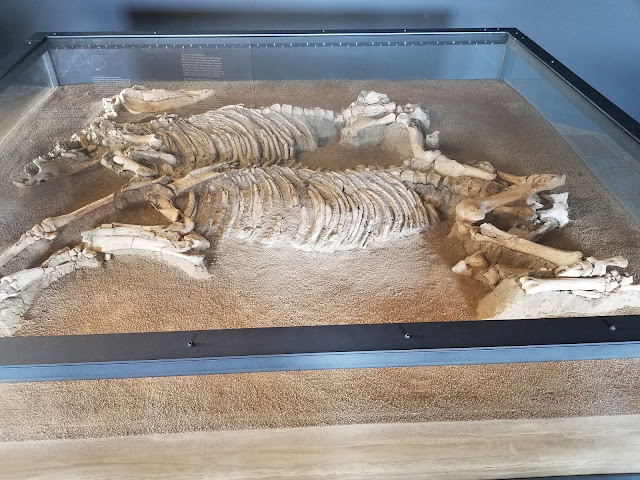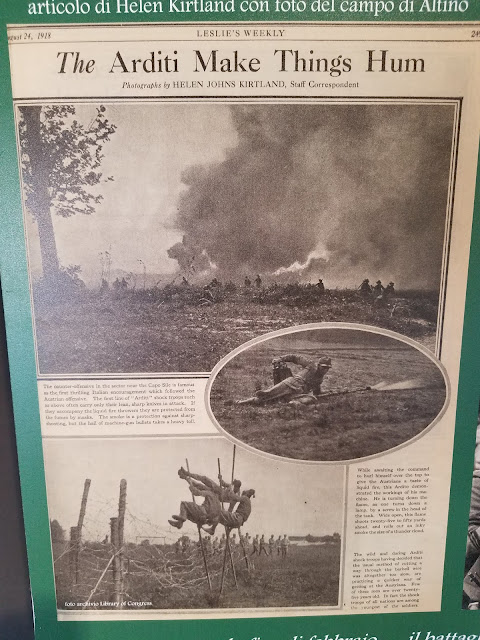Ravenna was a capital of the Roman Empire and is famous for its restored Byzantine mosaics.
 |
Some mosaics are newer.
|
 |
| This is an easy loop around the city center. We parked near Theoderic's Mausoleum. |
Ravenna became the capital of the Western Roman Empire in 402 AD when Emperor Honorius moved it there from Milan (Mediolanum). Ravenna was naturally defended by a swamp (that it is no longer surrounded by) and had a port that facilitated trade with the Eastern Roman Empire.
Neonian Baptistery
 |
| The oldest building in Ravenna is the Neonian Baptistery. |
 |
| The
structure and its mosaics were completed by Bishop Neon at the end of
the 5th century. |
Mausoleum of Galla Placidia
 |
| The Mausoleum of Galla Placidia was built in the 5th century and commissioned by its namesake. |
 |
| Galla Placidia was the daughter of the last Emperor of a united Roman
Empire, Theodosius I, and half-sister of Western Emperor Honorious. She
is not buried in the Mausoleum but in Rome, where she died after living
through the sack of Rome by Alaric the Visigoth, marrying his son,
Ataulf, and then the Western Roman Emperor, Constatius III. She also
served as regent for her son, Valentinian III. |
Mausoleum of Theoderic
 |
One of the oldest buildings in Ravenna is the Mausoleum of Theoderic, built in 520 AD. Theoderic was an Ostrogothic king who overthrew Odoacer,
a barbarian Roman soldier that ended the Western Roman Empire and
founded the Kingdom of Italy. Theoderic made peace with Odoacer in 493
and signed a treaty with him. A banquet was held after the treaty was
signed; that night Theoderic delivered a toast to Odoacer, then stabbed
him through the chest, killing him. Theoderic recognized nominal
suzerainty of the Eastern Roman Emperor, but de facto ruled Italy
independently until his death. He was buried in his Mausoleum in 526. By
540, despite the efforts of his daughter Amalasunta, a Byzantine general, Belisarius, captured Ravenna, scattered his bones, and converted the Mausoleum into a church. His statue in the tomb was taken to Pavia in the Middle Ages and later destroyed by Jacobins during the French Revolution.
Arian Baptistry |
 |
| The Arian Baptistry was built in the beginning of the 6th century at the
behest of Theodoric the Great, and is similar in style to the Neonian
Baptistry. Arianism states
that Jesus as the Son was subordinate to God, his father, a heresy in
the eyes of the Orthodox trinity. |
 |
| Theodoric and most of the Goths were
Arians, but coexisted peacefully with Orthodox Christians in Ravenna,
albeit in separate neighborhoods. |
 |
| The original mosaics were lost after
Arianism was suppressed by the Eastern Roman Empire when they recaptured
the city. |
Another UNESCO recognized church, the Archbishop's Chapel, housed in the Archiepiscopal Museum, also contains anti-Arian imagery (and no pictures are allowed!)
Basilica of Sant' Apollinare Nuovo
 |
| The Basilica of Sant' Apollinare Nuovo, dedicated in 504, was
commissioned by Theoderic at the same time as the Arian Baptistry. |
 |
| In 561 it was reconsecrated on order of Byzantine Emperor Justinian I. Its name was changed in 856 when relics of Saint Apollinaris were moved
to the church from Sant' Apollinare in Classe, another
UNESCO recognized church in Ravenna (to protect them from pirates) |
 |
| Ruins of Ravenna's ancient port can be visited on the outskirts of the city. |
 |
| Old Justinian! |
Basilica of San Vitale
 |
| The Basilica of San Vitale is the crown jewel of Ravenna. |
 |
| It was begun
by the Ostrogoths and completed in 547 by the Bishop of Ravenna, and
includes famous depictions of Emperor Justinian I and Empress Theodora (and some eunuchs). |
 |
| Justinian ordered his general Belisarius to reconquer much of the
Western Roman Empire. |
 |
| He succeeded in recapturing most of Italy by 540,
but by 575, the Lombards had invaded and only a few cities, including
Ravenna, remained in Byzantine hands. |
 |
| Empress Theodora |
 |
General Belisarius is to the left of Emperor Justinian. Eunuch General Narses is to the right.
|
Papal States and Ravenna
 |
| The Lombards finally conquered Ravenna in 751, only to quickly lose
it to the Papal States on order of the Franks. Charlemagne took many
mosaics from Ravenna to his capital in Aachen. |
Dante and Ravenna
 |
| Dante was sent on a diplomatic mission to Venice in 1321 on behalf of
Ravenna; the Venetians did not regard him as important enough to
warrant a mainland escort, which forced him to navigate the marshes
between the two cities. On the way back from Venice he contracted
Malaria and died soon after, and was buried in Ravenna. |
Venice and Ravenna
 |
| Ravenna was ruled by Venice during parts of the 15th and 16th centuries. |
 |
| During that time, they built Brancaleone (Lion's Claw) Fortress, which is now a beautiful public park. The Monster or Ravenna was also born during this period. |
Ravenna also has some excellent street art, pizza, and geese!





































































